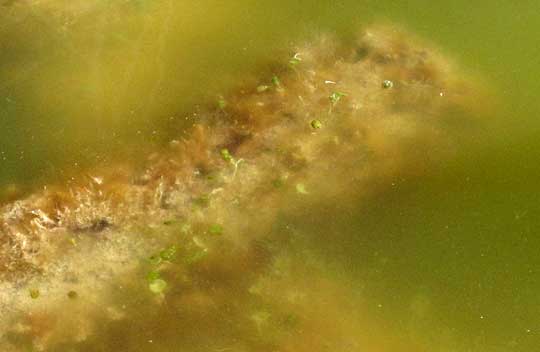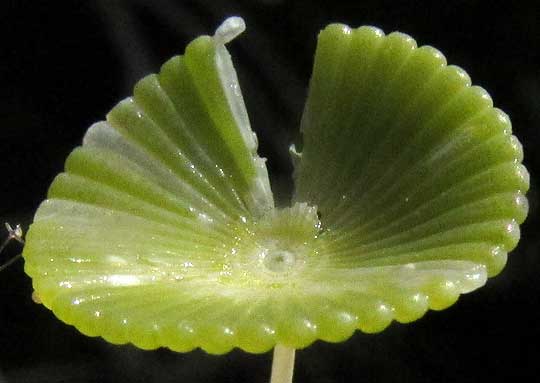Excerpts from Jim Conrad's
Naturalist Newsletter
from the March 22, 2015 Newsletter issued from Río Lagartos, on the Yucatan Peninsula's northern coast (~N21.60°, ~W88.16°), Yucatán state, MÉXICO
MERMAID'S WINEGLASS ALGA
During a flamingo tour up Ría Lagartos Estuary, Paco the guide spotted a young crocodile sunning on a log at the mangrove's edge, circled the boat back and drew close so the tourists could take their pictures. I've seen plenty of crocodiles so I was busy looking at other things; for example, the innocent-looking, alga-cloaked Red Mangrove root shown submerged just below the water's surface, shown below:

What caught my attention with this particular root was that besides the usual coat of reddish/yellowish/greenish algae, here and there arose small sprouts of seedling-like greenery. As tourists excitedly angled for good shots of the crock, whose throat was being tickled by the intrepid Paco, I leaned over the boat's edge and plucked some of the sprout-like things, which to me proved more exciting than the sunbathing crocodile. You can see what I'd found below:

Seldom have I seen such a graceful, pretty alga. A closer shot is shown below:

I figured that any such beautiful, idiosyncratic alga would be easy to identify, and that was right. First of all, it seemed unlikely that any common English name for the organism could avoid using the words "green," "parasol" and "alga," so a Google image search was made on the keywords "green parasol alga." On the first resulting page of thumbnails a picture turned up of an alga looking like ours, labeled "Acetabularia." Google had found the image because accompanying text described it as being parasol shaped. Happily, the list of alga species known to occur in Ría Lagartos Reserve included ACETABULARIA CRENULATA, and when other pictures of that species were sought, they looked just like our boatside discovery.
English names for this lovely little alga include Mermaid's Wine Glass and Mermaid's Parasol. Several parasol-shaped, aquatic organisms share these names, so probably it's best to use the Latin: Acetabularia crenulata. The species inhabits warmer waters practically worldwide. In our part of the world we find it from Florida south through the Gulf of Mexico and Caribbean to Brazil. It grows mostly in shallow, quiet waters attached to stones, rocks, shells and other submerged objects -- such as submerged Red Mangrove roots.
Our individuals were about an inch tall (25mm) but I read that they can reach three times that size. In the last picture the disk consisting of radiating segments, or filaments, is split, and that's typical of the species. Since this organism is a green alga, its filaments lack the kind of vascular network found in higher plants. In fact, technically, since the alga has no cell walls, with all cell contents residing together in a sort of big, parasol-shaped package, the whole organism is regarded as a single cell. In the literature it's described as a "single-celled organism, but gigantic in size and complex in form, making it an excellent model organism for studying cell biology."
In Acetabularia individuals, the single nucleus is located in the root-like rhizoid, so if the cap is snipped off, the cell can completely regenerate it. The caps of two Acetabularia can be exchanged -- even between two different species. If a piece of the stem is removed, with no access to the nucleus in the rhizoid, this isolated stem piece can also grow a new cap. Species of the genus Acetabularia are considered to be among the largest single-celled organisms, and each organism's nucleus is regarded as remarkably large.
What an amazing being to encounter amid a messy tangle of algae on a Red Mangrove root next to a sunbathing crocodile!